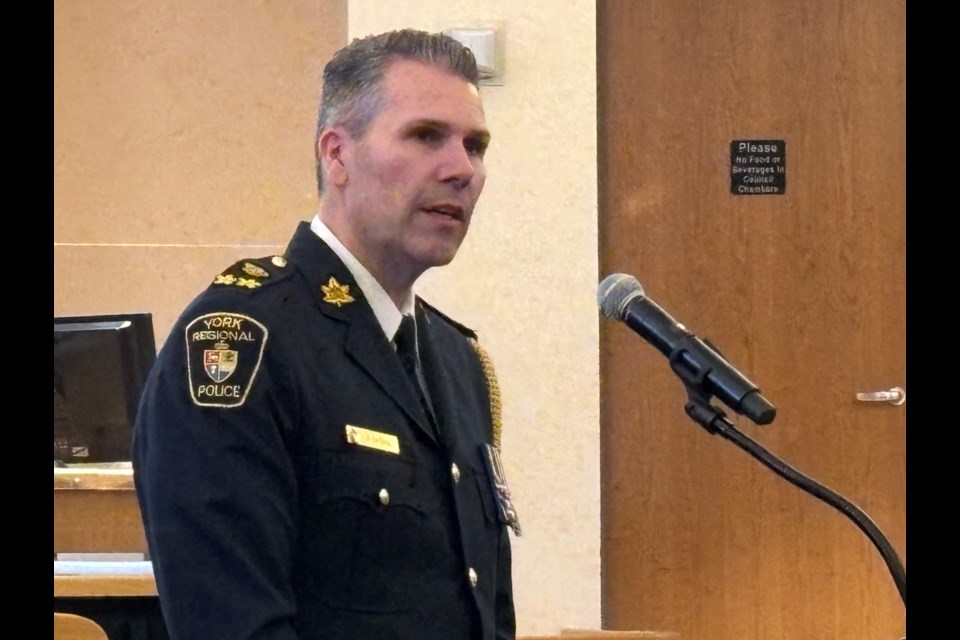With a mix of fear, anger and vulnerability, local resident Penney Reynolds shared how she felt when her house was broken into. It was a day she will never forget.
“I don’t feel safe, I am a victim, I had things taken that I can’t replace, but most importantly, someone was in my house, and someone even used my washroom,” said Reynolds, her voice trembling as she spoke at the community safety and crime prevention town hall hosted by York Regional Police, Aurora Mayor Tom Mrakas, and Newmarket-Aurora MPP Dawn Gallagher Murphy at Aurora Town Hall last night.
Reynolds said her daughter was at work, while she and her husband were away, when the break-in occurred. She said the thieves — who stole all her jewelry — trashed the house, left doors wide open, and removed pictures from the walls.
Reynolds called York Regional Police, who investigated the scene, and looked for fingerprints while she called a locksmith.
The house now has security cameras, but her daughter will no longer be there alone, she said.
“We have a cottage and we go away frequently. Now, we’re afraid to.”
Deputy Chief Paulo Da Silva thanked Reynolds for her courage in sharing her story and apologized that she was a victim.
“As a police officer for 30 years, being a victim of a break and enter is very impactful, and I’m sorry,” said Da Silva. “I hear the strain and concern in the voices in the chamber.”
Da Silva said he would tell his officers to drive through neighbourhoods instead of the main streets. He hopes Reynolds will notice more police presence.
Police shared statistics from its community safety portal, which features dashboards that provide crime, road safety, and theft of vehicle trends across the region.
Certain crimes are on the rise, but not all. Year to date in Aurora, there have been 15 residential break-and-enters, up from 10 (50 per cent increase), 14 commercial break and enters up from six, 11 drug violations compared to five (120 per cent increase), three robberies up from one (200 per cent increase) and six weapons violations classified as other compared to one (500 per cent increase).
Crimes are trending downward in other areas. There have been 45 assaults compared to 50 (a decrease of 10 per cent), no attempted murders, which has remained the same, one sexual violation as opposed to six (a decrease of 83.3 per cent), 21 theft of motor vehicles compared to 53 (decrease of 53.3 per cent), three incidents of theft over $5,000 down from eight (decrease of 62.5 per cent), no homicides, which remains the same, and one firearm violation, the same as amount last year.
“When we look at comparable communities within York Region, it’s not an absence of crime,” said Da Silva. “We’re not suggesting that it is an absence of crime, but when we talk about a 54 per cent increase, that amounts to a fivefold increase in relation to break and enters when it comes to the town of Aurora. It’s about the data and perspective.”
“With a rise in crime over the last few years, as a provincial government, we have committed to fighting crime by investing millions of dollars to combat various crimes from auto thefts to enhancing our court resources to prosecute criminals to standardizing investigative practices, particularly hate crimes, as well as addressing guns, gangs and violence reduction strategies,” Gallagher Murphy told the audience.
Resident Stephanie McCleave said she was encouraged to see many of her neighbours there and wants to be pro-active in fighting crime in her community.
“We don’t want to be sitting there whinging that we should have done something sooner,” said McCleave. “We want to work with police, the neighbourhood, and the community to try to make that happen so we can get ahead of that.”
McCleave would like to have a citizens patrol, signs to deter criminals, CCTV cameras at entry points on Bathurst, and drone surveillance.
“Maybe have drones patrol the neighbourhoods at night,” said McCleave. “It is less expensive than using the police. There should be no privacy issues as cameras are in use everywhere, schools, police cars, retail, dash cams, speed traps, 407, you know, even police helicopters.”
McCleave suggested drones can help during an attempted break-in. She said it can notify dispatchers rather than have police drive around high-risk areas.
Da Silva said Transport Canada has strict guidelines for drones. According to the government agency, people operating a drone are considered pilots. They share the skies with other aircraft and helicopters and must be flown far away from them. Pilots can face serious penalties, including fines and jail time if they break the rules, he said.
“Drones have to be tethered, they have to be operated, they can not fly alone,” said Da Silva. “In relation to technology, we are not there yet. Maybe sometime in the future that will be something that would be available but in our current day and age, we have drones, we have a few we can use, and they have to be operated by an individual.”
Da Silva does not want to minimize the effects of crime, but he emphasized the town is a relatively safe community compared to other jurisdictions.
